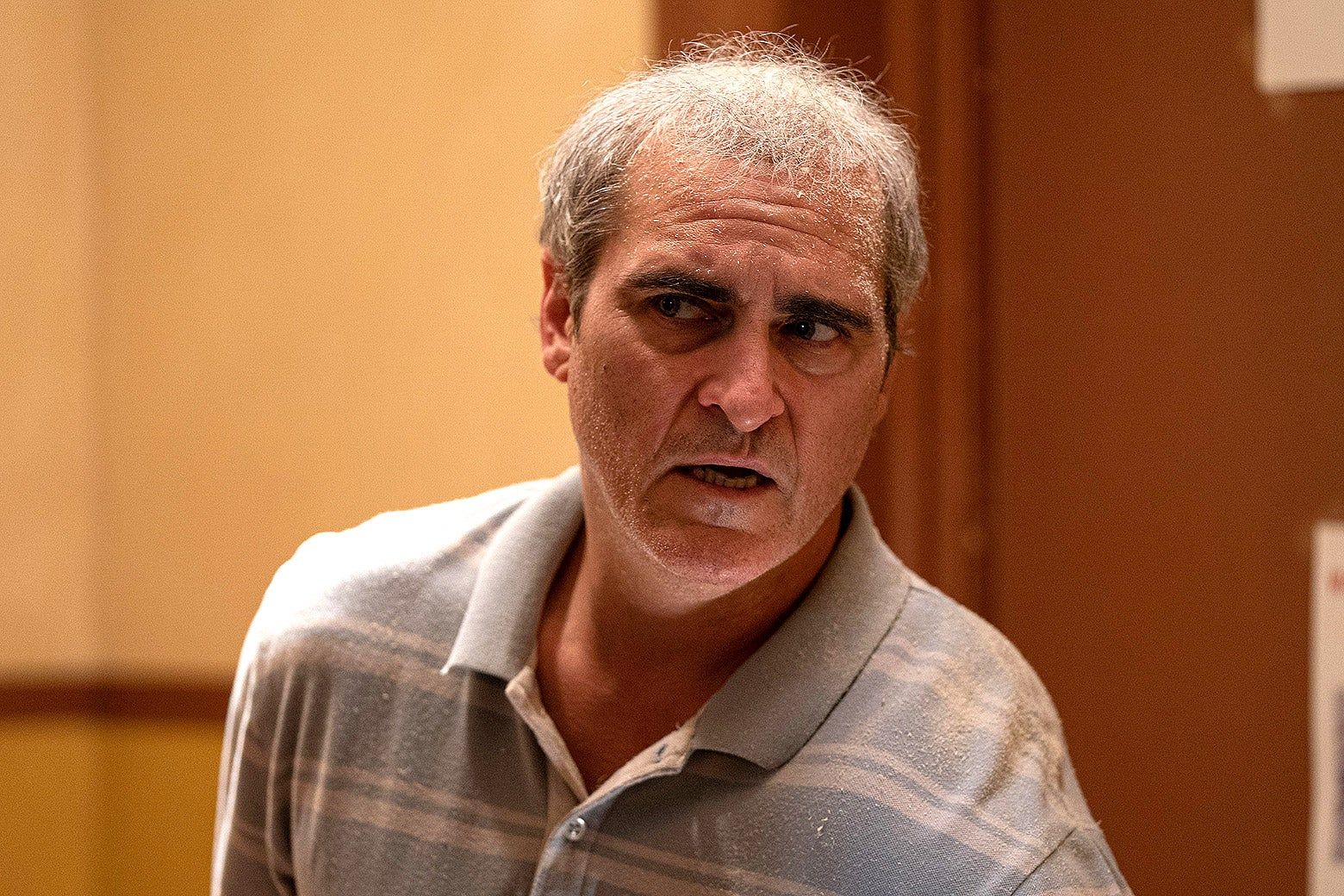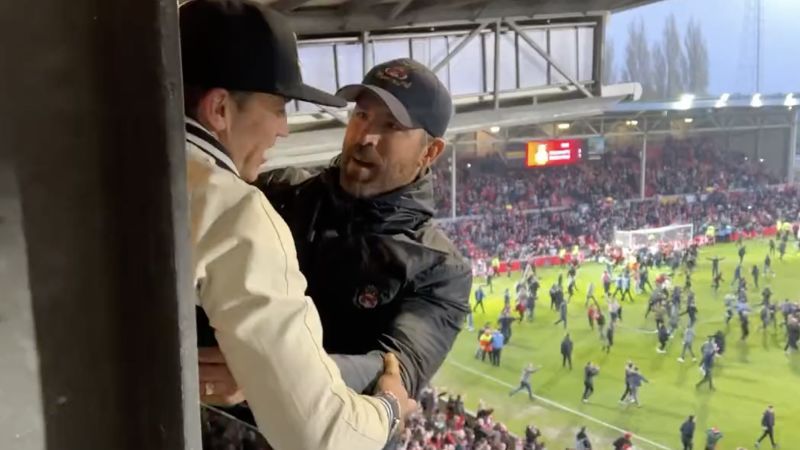The hidden messages in Ari Aster’s new A24 movie.
At the beginning of Ari Aster’s new film Beau Is Afraid, our hero, Beau Wasserman, walks down the sidewalk, fidgeting with a bottle of a “cool new drug” called Zypnotycril. The camera follows him as he passes a woman wearing a sandwich board that says “I WILL CUT MY OWN HANDS OFF,” a kiosk labeled “Guns Aplenty,” next to which a guy is calmly sighting and chambering a big rifle, and ads for “Angel Cream” baby emollient and “Gentle & Easy” floss, both Perfectly Safe products made by the MW company—whose logo, oddly, appears before the first shot, alongside the logos for A24 and Square Peg (Aster and Lars Knudsen’s production company). There are also a number of ads for a “one night only immersive theatrical experience” called To Never Die. There is a mean-faced little boy playing with a radio-controlled toy boat that sputters, capsized, in a fountain; his irate mom, screaming, “Listen to your mother!” drags him away as Beau passes. As Beau heads home, he passes a convenience store called the Cheapo Depot and settles into his apartment above to a ’70s, Times Square–style peep show venue called Erectus Ejectus.
Advertisement
Advertisement
Advertisement
Advertisement
Beau Is Afraid is three hours long, packed with ominous signifiers, sight gags, and sight gags that ominously signify. It’s a lot, and I left feeling worn out by its shrill, Freudian excesses. Then I went to bed, and when I woke up it was one of my favorite movies, so much so that I begged a beleaguered press rep from A24 to let me watch it again, in a format I could pause so I could scrutinize what I can describe only as a Simpsons-level surfeit of signage. Then I asked for an interview with the production designer, Fiona Crombie, so I could grill her about things like the nature of the MW corporation, and the huge sequence on the set of To Never Die, and the feeling that that the film’s impossibly dense deluge thicket of signifiers is not merely generally oppressive but specifically oppressive. Everything, from the boy band posters adorning the room in which he convalesces after a naked auto accident to the plaque memorializing the descent of a fatal chandelier, seems designed to oppress Beau himself, the way everything made by the Acme Corporation seems to have been designed to injure and humiliate Wile E. Coyote.
Advertisement
Sign up for the Slate Culture Newsletter The best of movies, TV, books, music, and more, delivered to your inbox. We encountered an issue signing you up. Please try again. Please enable javascript to use form. Email address: Send me updates about Slate special offers. By signing up, you agree to our Privacy Policy and Terms Sign Up Thanks for signing up! You can manage your newsletter subscriptions at any time.
Crombie was very nice, and had lots of interesting information about the Erectus Ejectus establishment, which boasts a sign about 10 feet high with an elaborate menu advertising the carnal peculiarities offered within. She also likes Chekhov. This interview has condensed and edited for clarity.
Sam Thielman: There are so many signs in Beau Is Afraid that I asked A24 to send me a digital screener so I could pause the movie to read them all. I think I realized I was going to do this when I read the sign about the brown recluse loose in Beau’s building with the Winston Churchill quote—“the price of greatness is responsibility”—at the bottom, which somehow felt exactly like how a big-city landlord would approach tenants afraid of poisonous spiders. I’m curious who wrote all these, especially the one in the lobby that reads “HAIL SATAN/SHOOT DOPE/KILL KIDS/FUCK THE POPE”?
Advertisement
Advertisement
Fiona Crombie: That’s all the mind of Ari Aster. We had Google Docs going, where, if anybody who had an idea about a sign or a product or an action that somebody in the background might be doing, they could write it down.
Who was in that group?
Advertisement
Advertisement
It was Ari, Lars [Knudsen, the producer], [co-producer] Tyler [Campellone], Alice Babidge, the costume designer. Ann Ruark, the executive producer. It was a group of us that were always trying to better each other. But I mean, I failed early. I broke one thing. Like, no one went “haha!” or anything. I leave it to the experts.
So, to some extent, this movie is about the way Mona, the Patti LuPone character, controls Beau’s life, and a lot of it seems to be through her company, which makes all of these wild products. Mona Wasserman’s MW logo is even displayed as one of the production companies at the beginning of the movie. How did you talk about creating the world that she herself seems to have created pretty much in its entirety?
Advertisement
There’s a moment in her—well, we call it her workshop, but it’s that sort of office space at the end [of the film]. Beau walks through, and he sees all the publicity [materials] and the timeline of the company, and as he walks down the stairs, he looks at photographs of himself that are used in [Mona’s] advertising. I thought about it in terms of ways Mona has tried to solve his life. Like, when he had an allergy, she created an allergy medicine, or [when he had acne,] an acne medicine. When he was a baby, baby stuff. We went through his ages, thinking, “What are the things he might need?” Her whole empire is built around things for him, and in the end it becomes housing and then it becomes security and then it becomes antidepressants. So we plotted that through different stages of his life.
Advertisement
Advertisement
Advertisement
I liked that the brand is always Perfectly Safe. There’s quite an ominous billboard of little Beau flossing, with a scary guy standing in the shadows right behind him.
We had a lot of Perfectly Safe products. Perfectly Safe: For Men.
“Pour homme.”
Exactly.
I spent a lot of time laughing about the porno shop below Beau’s apartment, Erectus Ejectus, which has a big sex menu displayed to the general public.
Oh, that’s all real.
What?
Actually, all of that text came from my supervising art director, who had been on a holiday somewhere—I can’t remember where—and he had all the text in a photo. And he told Ari, and Ari said, “Yes, let’s do that.”
Advertisement
There’s a real Erectus Ejectus store somewhere.
Not the name of the store, but the menu is apparently all real. [The most visible part of the menu in question reads: “PUSSY CHANGE WATER/KNIFE DICK (stab other man)/PUSSY WRITE LETTER/PUSSY SHOOT BALLOON/PUSSY FROG WHISTLE/PUSSY BIRTHDAY FLOWER/PERFECTLY NORMAL COCK.”] I didn’t do any Google searches.
Yes, I’m not going to do that either. [In the interest of journalistic rigor, I did later Google “pussy frog whistle.” The only hit was a review of the movie.] I remain completely fascinated by the degree to which this was all planned out. There’s that little capsized boat at the beginning, which sort of prefigures Beau’s weird execution in a capsized boat at the end—just so much in every shot.
Advertisement
Advertisement
Advertisement
I think Ari really enjoys layering things with meaning. I didn’t necessarily know why there needed to be a boat there—why there needed all these kinds of symbols, but they were there. And I think that he puts them in so that you find your own reason for them, but there is a real density of imagery. And that’s very, very deliberate. He wants to push it as much as he can.
Advertisement
So your background is primarily in the theater. You’ve done Shakespeare and Chekhov.
I have.
I wanted to ask you about the big scene where Beau meets the nomadic theater troupe that has been advertised in the background since the beginning of the movie.
Advertisement
Um, well, do you know what—in all honesty, I had been watching that TV show Alone.
Oh no.
And I became obsessed with their wooden whittled structures, and I just was like, “I just think it all needs to be out of wood.” We had talked about the fact that they’re a traveling troupe, and the whole idea is they can pack up. They could just, like, come in anywhere, they can build a theater, and they can put on a show. That was the logic. And I thought, “Finally I have an outlet for my Alone”—
Your Alone mania.
Yeah. You sort of see how they live: We had little cooking areas, and we had the costume storage, and we tried to kind of have the logic. Those sets are really hard, because they have almost no end. It’s like a battlefield. I’ve done a lot of battlefields, and, you know, you could have tents for days. You can just go on and on and on. It’s actually the same feeling, doing that space, because of the forest. You can just keep going and going and going.
Advertisement
That’s a huge set, but then there are other huge sets too, because there are so many locations in this kind of episodic story. The palette changes really dramatically from place to place.
Yeah, there’s this first section, and that’s mustards and yellows and grimy, and then we get to the pinks [when Beau finds himself in a teenage girl’s bedroom], and we’re changing the colors and the textures for each beat so that they feel distinct. This is The Worst Version of an apartment block. This is The Most Amazing Version of a domestic environment. The intention is that there’s a slightly constructed, deliberate element to all of it.
Source: Slate


